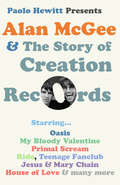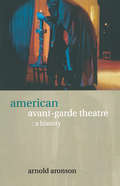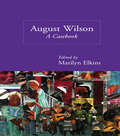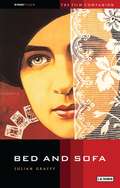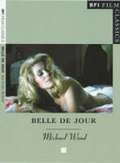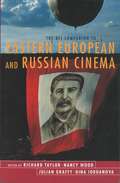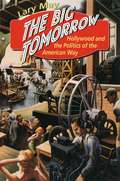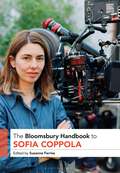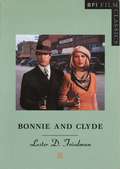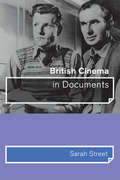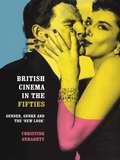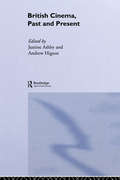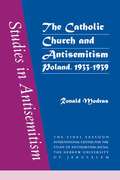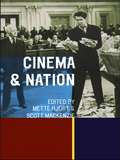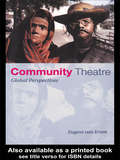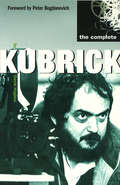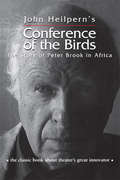- Table View
- List View
Alan McGee and The Story of Creation Records: This Ecstasy Romance Cannot Last
by Paolo HewittAlan McGee's legendary Creation record label brought us Oasis, Primal Scream, Jesus and Mary Chain, My Bloody Valentine, House of Love, Teenage Fanclub and many of the other most exciting and innovative bands of the eighties and nineties. But it also eventually brought McGee to a breakdown so complete that it took him two years to recover. Alan McGee started Creation in 1983 with a loan of ?1,000. McGee considered himself a loser when it came to school, girls and good looks, but he had two things on his side: punk attitude and an uncanny ability to detect musical genius. Within two years, McGee had launched The Jesus and Mary Chain, sold hundreds of thousands of records and created an indie empire that was a byword for headstrong independence. By 1992, McGee was a millionaire, living an unrestrained hedonistic lifestyle. In 1993 he discovered Oasis, and within a year of partying with the band he entered rehab following a near-death experience in Los Angeles. Paolo Hewitt, the bestselling biographer of Oasis, received full co-operation from Alan McGee and all the key Creation personnel for this candid, often funny, sometimes shocking oral history. It captures in vivid colour one of the richest chapters in British rock history. Creation and its roster are going to live forever.
American Avant-Garde Theatre: A History (Theatre Production Studies)
by Arnold AronsonThis stunning contribution to the field of theatre history is the first in-depth look at avant-garde theatre in the United States from the early 1950s to the 1990s. American Avant-Garde Theatre offers a definition of the avant-garde, and looks at its origins and theoretical foundations by examining: *Gertrude Stein *John Cage *The Beat writers *Avant-garde cinema *Abstract Expressionism *Minimalism There are fascinating discussions and illustrations of the productions of the Living Theatre, the Wooster Group, Open Theatre, Ontological-Hysteric Theatre and Performance Group. among many others. Aronson also examines why avant-garde theatre declined and virtually disappeared at the end of the twentieth century.
American Avant-Garde Theatre: A History (Theatre Production Studies)
by Arnold AronsonThis stunning contribution to the field of theatre history is the first in-depth look at avant-garde theatre in the United States from the early 1950s to the 1990s. American Avant-Garde Theatre offers a definition of the avant-garde, and looks at its origins and theoretical foundations by examining: *Gertrude Stein *John Cage *The Beat writers *Avant-garde cinema *Abstract Expressionism *Minimalism There are fascinating discussions and illustrations of the productions of the Living Theatre, the Wooster Group, Open Theatre, Ontological-Hysteric Theatre and Performance Group. among many others. Aronson also examines why avant-garde theatre declined and virtually disappeared at the end of the twentieth century.
August Wilson: A Casebook (Casebooks on Modern Dramatists #Vol. 15)
by Marilyn ElkinsFirst Published in 2000. Routledge is an imprint of Taylor & Francis, an informa company.
August Wilson: A Casebook (Casebooks on Modern Dramatists)
by Marilyn ElkinsFirst Published in 2000. Routledge is an imprint of Taylor & Francis, an informa company.
Bed and Sofa: The Film Companion (KINOfiles Film Companion)
by Julian GraffyAbram Room's daring 1927 film is the story of a ménage à trois - one woman, two men - set in a 1920s Moscow flat. Remarkable for its frankness, humour and corrosive assessment of the new Soviet society, particularly the new Soviet man, _Bed and Sofa_ has found new and enthusiastic audiences in recent years.
Belle de Jour (BFI Film Classics)
by Michael WoodSeverine (Catherine Deneuve) is a listless haute bourgeouise wife with a secret afternoon life of prostitution. Her life twists repression and guilt together with uninhibited behaviour, strangled libido with its liberated counterpart. Luis Bunuel was catapulted into cinematic history by his groundbreaking Dali collaboration, Un Chien Andalou, in 1929, but it is Belle de Jour (1967) which inaugurates the extraordinary late phase of his work. It is a film shimmering with reflections on truth, fiction and fantasy, in addition to caustic social insight, as it tells the story of a woman clearing her mind, perhaps, of its ghosts.
The BFI Companion to Eastern European and Russian Cinema
by Richard Taylor Nancy Wood Julian Graffy WThis work maps the rich, varied cinema of Eastern Europe, Russia and the former USSR. Over 200 entries cover a variety of topics spanning a century of endeavour and turbulent history from Czech animation to Soviet montage, from the silent cinemas dating back to World War I through to the varied responses to the conflicts in the former Yugoslavia. It includes entries on actors and actresses, film festivals, studios, genres, directors, film movements, critics, producers and technicians, taking the coverage up to the late 1990s. In addition to the historical material of key figures like Eisenstein and Wadja, the editors provide separate accounts of the trajectory of the cinemas of Eastern Europe and of Russia in the wake of the collapse of communism.
The Big Tomorrow: Hollywood and the Politics of the American Way
by Lary MayIn this daring reexamination of the connections between national politics and Hollywood movies, Lary May offers a fresh interpretation of American culture from the New Deal through the Cold War—one in which a populist, egalitarian ethos found itself eventually supplanted by a far different view of the nation. "One of the best books ever written about the movies." —Tom Ryan, The Age "The most exhilarating work of revisionist film history since Pauline Kael's Citizen Kane. . . . May's take on what movies once were (energizing, as opposed to enervating), and hence can become again, is enough to get you believing in them again as one of the regenerative forces America so sorely needs."—Jay Carr, Boston Globe "A startling, revisionist history of Hollywood's impact on politics and American culture. . . . A convincing and important addition to American cultural criticism."—Publishers Weekly "A controversial overview of 30 years of American film history; must reading for any serious student of the subject."—Choice "A provocative social history of Hollywood's influence in American life from the 1930s to the 1950s. May argues persuasively that movies in the period offered a good deal of tough criticism of economic and social conditions in U.S. society. . . . May challenges us to engage in some serious rethinking about Hollywood's impact on American society in the middle of the twentieth century."—Robert Brent Toplin, American Historical Review
The Bloomsbury Handbook to Sofia Coppola (Bloomsbury Handbooks)
by Suzanne FerrissThe Bloomsbury Handbook to Sofia Coppola offers the first comprehensive overview of the director's impressive oeuvre. It includes individual chapters on her films, including The Virgin Suicides (1999), Lost in Translation (2003), Marie Antoinette (2006), Somewhere (2010), The Bling Ring (2013), The Beguiled (2017), and On the Rocks (2020). While focused on her films, contributors also consider Coppola's shorter works for television, commercials and music videos, as well as explorations of the distinct elements of her signature style: cinematography, production/costume design, music, and editing. Additional chapters provide insights into the influences on her work, its popular and scholarly reception, and interpretations of key themes and issues.The international team of contributors includes leading scholars of film, music, fashion, celebrity and gender studies, visual and material culture, reception studies, as well as industry professionals. Their interdisciplinary insights capture the complexities of Coppola's work and its cultural significance.
Bonnie and Clyde (BFI Film Classics)
by Lester D. FriedmanBonnie and Clyde (Arthur Penn, 1967) scandalised mainstream popular opinion. Part of an emerging youth and protest movement, its graphic and balletic violence was highly subversive in the context of the war in Vietnam. It spoke directly to younger audiences, who were already pitted against their more conservative elders and easily identified with the characters played by Warren Beatty (who also produced the film) and Faye Dunaway. Bonnie and Clyde was the prototype of 1970s 'New Hollywood': anti-authority, candid about sex, morally neutral. As well as changing Hollywood film style, Bonnie and Clyde changed critical attitudes. Older critics loathed the film at first. But younger critics, led by the then little-known Pauline Kael, fought a rearguard action and won the day. Recognising Bonnie and Clyde's distinctive position in the evolution of American culture and cinema history, Lester D. Friedman explores the film's cultural framework, examines the contributions of its creators and presents a detailed visual and thematic analysis.
British Cinema in Documents
by Sarah StreetBritish Cinema in Documents presents an introduction to the key concerns and debates in British cinema through documents, ranging from official papers to fan magazines. Sarah Street shows how such documentary material can enrich our understanding of cinema's place in national culture and shed new light on defining moments in British cinema history.Street draws together a wide range of material, discussing oral histories, film posters and stills and star memorabilia alongside audience surveys, censorship reports, fan magazines and web sites, providing a context for each extract she discusses. She uses a series of case studies, including film censorship during the Second World War, the fan cultures surrounding stars from Margaret Lockwood to Ewan McGregor, and surveys of the British cinema audience to illustrate how archival research can provide a new understanding of the relationship between a film and other kinds of texts, and between films, their audiences, and the state.
British Cinema in Documents
by Sarah StreetBritish Cinema in Documents presents an introduction to the key concerns and debates in British cinema through documents, ranging from official papers to fan magazines. Sarah Street shows how such documentary material can enrich our understanding of cinema's place in national culture and shed new light on defining moments in British cinema history.Street draws together a wide range of material, discussing oral histories, film posters and stills and star memorabilia alongside audience surveys, censorship reports, fan magazines and web sites, providing a context for each extract she discusses. She uses a series of case studies, including film censorship during the Second World War, the fan cultures surrounding stars from Margaret Lockwood to Ewan McGregor, and surveys of the British cinema audience to illustrate how archival research can provide a new understanding of the relationship between a film and other kinds of texts, and between films, their audiences, and the state.
British Cinema in the Fifties: Gender, Genre and the 'New Look' (Communication And Society Ser.)
by Christine GeraghtyIn the fifties British cinema won large audiences with popular war films and comedies, creating stars such as Dirk Bogarde and Kay Kendall, and introducing the stereotypes of war hero, boffin and comic bureaucrat which still help to define images of British national identity. In British Cinema in the Fifties, Christine Geraghty examines some of the most popular films of this period, exploring the ways in which they approached contemporary social issues such as national identity, the end of empire, new gender roles and the care of children.Through a series of case studies on films as diverse as It Always Rains on Sunday and Genevieve, Simba and The Wrong Arm of the Law, Geraghty explores some of the key debates about British cinema and film theory, contesting current emphases on contradiction, subversion and excess and exploring the curious mix of rebellion and conformity which marked British cinema in the post-war era.
British Cinema in the Fifties: Gender, Genre and the 'New Look'
by Christine GeraghtyIn the fifties British cinema won large audiences with popular war films and comedies, creating stars such as Dirk Bogarde and Kay Kendall, and introducing the stereotypes of war hero, boffin and comic bureaucrat which still help to define images of British national identity. In British Cinema in the Fifties, Christine Geraghty examines some of the most popular films of this period, exploring the ways in which they approached contemporary social issues such as national identity, the end of empire, new gender roles and the care of children.Through a series of case studies on films as diverse as It Always Rains on Sunday and Genevieve, Simba and The Wrong Arm of the Law, Geraghty explores some of the key debates about British cinema and film theory, contesting current emphases on contradiction, subversion and excess and exploring the curious mix of rebellion and conformity which marked British cinema in the post-war era.
British Cinema, Past and Present
by Justine Ashby Andrew HigsonBritish Cinema: Past and Present responds to the commercial and critical success of British film in the 1990s. Providing a historical perspective to the contemporary resurgence of British cinema, this unique anthology brings together leading international scholars to investigate the rich diversity of British film production, from the early sound period of the 1930s to the present day.The contributors address:* British Cinema Studies and the concept of national cinema* the distribution and reception of British films in the US and Europe* key genres, movements and cycles of British cinema in the 1940s, 50s and 60s* questions of authorship and agency, with case studies of individual studios, stars, producers and directors* trends in British cinema, from propaganda films of the Second World War to the New Wave and the 'Swinging London' films of the Sixties* the representation of marginalised communities in films such as Trainspotting and The Full Monty* the evolution of social realism from Saturday Night, Sunday Morning to Nil By Mouth* changing approaches to Northern Ireland and the Troubles in films like The Long Good Friday and Alan Clarke's Elephant* contemporary 'art' and 'quality' cinema, from heritage drama to the work of Peter Greenaway, Derek Jarman, Terence Davies and Patrick Keiller.
British Cinema, Past and Present
by Justine Ashby Andrew HigsonBritish Cinema: Past and Present responds to the commercial and critical success of British film in the 1990s. Providing a historical perspective to the contemporary resurgence of British cinema, this unique anthology brings together leading international scholars to investigate the rich diversity of British film production, from the early sound period of the 1930s to the present day.The contributors address:* British Cinema Studies and the concept of national cinema* the distribution and reception of British films in the US and Europe* key genres, movements and cycles of British cinema in the 1940s, 50s and 60s* questions of authorship and agency, with case studies of individual studios, stars, producers and directors* trends in British cinema, from propaganda films of the Second World War to the New Wave and the 'Swinging London' films of the Sixties* the representation of marginalised communities in films such as Trainspotting and The Full Monty* the evolution of social realism from Saturday Night, Sunday Morning to Nil By Mouth* changing approaches to Northern Ireland and the Troubles in films like The Long Good Friday and Alan Clarke's Elephant* contemporary 'art' and 'quality' cinema, from heritage drama to the work of Peter Greenaway, Derek Jarman, Terence Davies and Patrick Keiller.
The Catholic Church and Antisemitism
by Ronald ModrasInterwar Poland was home to more Jews than any other country in Europe. Its commonplace but simplistic identification with antisemitism was due largely to nationalist efforts to boycott Jewish business. That they failed was not for want of support by the Catholic clergy, for whom the ''Jewish question'' was more than economic. The myth of a Masonic-Jewish alliance to subvert Christian culture first flourished in France but held considerable sway over Catholics in 1930s Poland as elsewhere. This book examines how, following Vatican policy, Polish church leaders resisted separation of church and state in the name of Catholic culture. In that struggle, every assimilated Jew served as both a symbol and a potential agent of security. Antisemitism is no longer regarded as a legitimate political stance. But in Europe, the United States, and the Middle East, the issues of religious culture, national identity, and minorities are with us still. This study of interwar Poland will shed light on dilemmas that still effect us today.
The Catholic Church and Antisemitism
by Ronald ModrasInterwar Poland was home to more Jews than any other country in Europe. Its commonplace but simplistic identification with antisemitism was due largely to nationalist efforts to boycott Jewish business. That they failed was not for want of support by the Catholic clergy, for whom the ''Jewish question'' was more than economic. The myth of a Masonic-Jewish alliance to subvert Christian culture first flourished in France but held considerable sway over Catholics in 1930s Poland as elsewhere. This book examines how, following Vatican policy, Polish church leaders resisted separation of church and state in the name of Catholic culture. In that struggle, every assimilated Jew served as both a symbol and a potential agent of security. Antisemitism is no longer regarded as a legitimate political stance. But in Europe, the United States, and the Middle East, the issues of religious culture, national identity, and minorities are with us still. This study of interwar Poland will shed light on dilemmas that still effect us today.
Cinema and Nation
by Mette Hjort Scott MackenzieIdeas of national identity, nationalism and transnationalism are now a central feature of contemporary film studies, as well as primary concerns for film-makers themselves. Embracing a range of national cinemas including Scotland, Poland, France, Turkey, Indonesia, India, Germany and America, Cinema and Nation considers the ways in which film production and reception are shaped by ideas of national belonging and examines the implications of globalisation for the concept of national cinema.In the first three Parts, contributors explore sociological approaches to nationalism, challenge the established definitions of 'national cinema', and consider the ways in which states - from the old Soviet Union to contemporary Scotland - aim to create a national culture through cinema. The final two Parts address the diverse strategies involved in the production of national cinema and consider how images of the nation are used and understood by audiences both at home and abroad.
Cinema and Nation
by Mette Hjort Scott MacKenzieIdeas of national identity, nationalism and transnationalism are now a central feature of contemporary film studies, as well as primary concerns for film-makers themselves. Embracing a range of national cinemas including Scotland, Poland, France, Turkey, Indonesia, India, Germany and America, Cinema and Nation considers the ways in which film production and reception are shaped by ideas of national belonging and examines the implications of globalisation for the concept of national cinema.In the first three Parts, contributors explore sociological approaches to nationalism, challenge the established definitions of 'national cinema', and consider the ways in which states - from the old Soviet Union to contemporary Scotland - aim to create a national culture through cinema. The final two Parts address the diverse strategies involved in the production of national cinema and consider how images of the nation are used and understood by audiences both at home and abroad.
Community Theatre: Global Perspectives
by Eugene van ErvenCommunity theatre is an important device for communities to collectively share stories, to participate in political dialogue, and to break down the increasing exclusion of marginalised groups of citizens. It is practised all over the world by growing numbers of people. Published at the same time as a video of the same name, this is a unique record of these theatre groups in action. Based on van Erven's own travels and experiences working with community theatre groups in six very different countries, this is the first study of their work and the methodological traditions which have developed around the world.
Community Theatre: Global Perspectives
by Eugene van ErvenCommunity theatre is an important device for communities to collectively share stories, to participate in political dialogue, and to break down the increasing exclusion of marginalised groups of citizens. It is practised all over the world by growing numbers of people. Published at the same time as a video of the same name, this is a unique record of these theatre groups in action. Based on van Erven's own travels and experiences working with community theatre groups in six very different countries, this is the first study of their work and the methodological traditions which have developed around the world.
The Complete Kubrick
by David HughesWith just thirteen feature films in half a century, Stanley Kubrick established himself as one of the most accomplished directors in motion picture history. Kubrick created a landmark and a benchmark with every film; working in almost every genre imaginable, including film noir, war movie, SF, horror, period drama, historical epic, love story and satire - yet transcended traditional genre boundaries with every shot. Examining every feature film, from the early shorts through to classics such as Paths of Glory, Dr Strangelove, 2001: A Space Odyssey, A Clockwork Orange, The Shining, Full Metal Jacket and finally, Eyes Wide Shut, The Complete Kubrick provides a unique insight into understanding the work of cinema's most enigmatic, iconoclastic and gifted auteur.
Conference of the Birds: The Story of Peter Brook in Africa
by John HeilpernConference of the Birds is John Heilpern's true story of an extraordinary journey. In December 1972, the director Peter Brook and an international troupe of actors (Helen Mirren and Yoshi Oida among them) left their Paris base to emerge again in the Sahara desert. It was the start of an 8,500-mile expedition through Africa without precedent in the history of theater. Brook was in search of a new beginning that has since been revealed in all his work--from Conference of the Birds and Carmen to The Mahabharata and beyond. At the heart of John Heilpern's brilliant account of the African experiment is a story that became a search for the miraculous.
